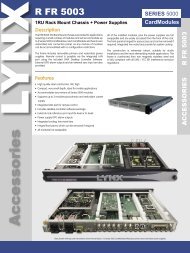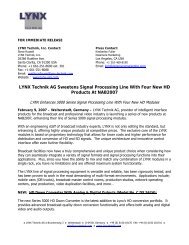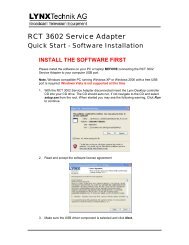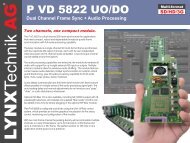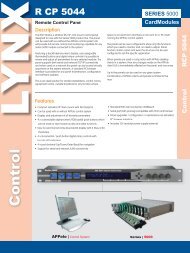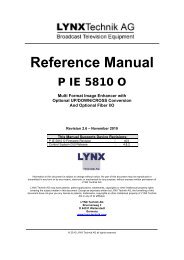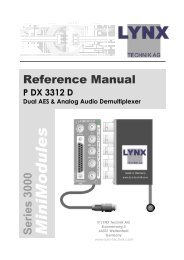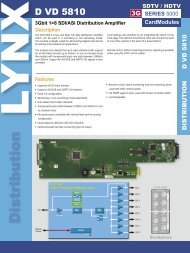Create successful ePaper yourself
Turn your PDF publications into a flip-book with our unique Google optimized e-Paper software.
Fiber Implementation<br />
A host of Series | 5000 modules now provide fi ber optic I/O<br />
capability. While fi ber I/O is not unique for terminal equipment,<br />
the <strong>LYNX</strong> <strong>Technik</strong> implementation is extremely well engineered.<br />
<strong>LYNX</strong> <strong>Technik</strong> uses small and modular SFP sub-modules for fi ber<br />
I/O. Adding fi ber capability or changing system confi gurations<br />
(wavelengths) is straightforward and simple.<br />
Fiber Solutions<br />
With the introduction of HDTV, 1.5Gbit, and 3Gbit<br />
bandwidth signals, the need to adopt fi ber interfaces<br />
is a requirement. Fiber offers many benefi ts compared<br />
to copper interfaces, with the greatest advantage<br />
being distance with no degredation of signal quality.<br />
The other benefi ts of fi ber include: sending and<br />
receiving multiple bi-directional signals over a single<br />
fi ber link, zero noise or interference, and signifi cantly<br />
less bulk. <strong>LYNX</strong> <strong>Technik</strong> has fully embraced fi ber<br />
technology and offers a wide range of solutions to<br />
address fi ber infrastructure design.<br />
FIBER SOLUTIONS<br />
SFP Fiber Sub Module<br />
<strong>LYNX</strong> <strong>Technik</strong> offers a full range of SFP fi ber<br />
sub-modules, which range from basic non-<br />
CWDM fi xed wavelength transmitters to a full<br />
range of CWDM transmitters with 18 selectable<br />
wavelengths. The solutions are ideal for<br />
simple point-to-point applications or complex<br />
multiplexed applications.<br />
Our basic SFP modules support distances up<br />
to 10km, and our CWDM solutions support<br />
distances up to 40km or 80km.<br />
Module and Backplane Connected<br />
CWDM<br />
<strong>LYNX</strong> <strong>Technik</strong> offers comprehensive support for CWDM (Coarse Wavelength Division Multiplexing) with 18<br />
selectable laser wavelengths as specifi ed by ITU-T G692.2. CWDM is a process used to optically multiplex<br />
signals into a single fi ber link. By selecting different wavelength fi ber transmitters and using the <strong>LYNX</strong> OCM<br />
passive optical multiplexers, it is easy to confi gure a bi-directional CWDM fi ber transmission system. Our<br />
CWDM solutions service distances up to 40km, and our long-haul transmitters and receivers are suitable<br />
for applications up to 80km.<br />
Non-CWDM<br />
CWDM Fiber modules use precision narrow band lasers and therefore cost more. For simple applications<br />
that only require single point to point fi ber connections, a “non CWDM” or basic fi ber SFP module is a more<br />
cost-effective solution.<br />
Passive Fiber System Components<br />
Working with light vs. electricity allows for us to use passive optical building blocks for a fi ber optic system<br />
design. Passive = no power requirements. Our solutions for fi ber include optical CWDM multiplexers,<br />
splitters, and combiners. We adhere to the highest standards of superior technical performance and all of<br />
our products are designed and manufactured in Germany.<br />
Fiber Option Selection Tables<br />
We offer a wide range of SFP fi ber options for our modules which include fi ber support in this section<br />
of the catalog. The module listings will refer to the tables show on the next page for the selection of the<br />
appropriate SFP fi ber option.<br />
Fiber Backplane Sockets on Module<br />
Backplane with Integrated Fiber<br />
L<strong>LYNX</strong> <strong>Technik</strong> fi ber solutions are unique in that the fi ber I/O is integrated into the backplane assembly.<br />
This means the module can be removed the rack for ease of service and without disconnecting the<br />
fi ber cables from the module. Other solutions on the market often have the fi ber I/O directly fi xed to<br />
the module and fed through the rear of the rack. When a module is removed, the delicate fi ber cables<br />
are pulled, which can result in damage. There is also no requirement for fi ber “service loops” on the<br />
modules.<br />
26



